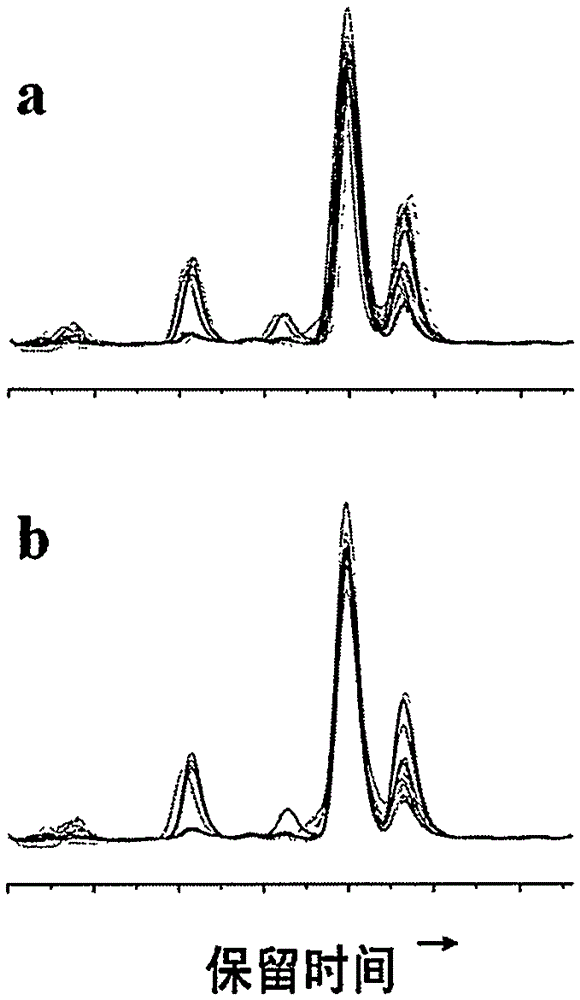Method for identifying regenerated polyester generated through chemical recycling method
A technology for chemical recycling and regeneration of polyester, applied in scientific instruments, biological neural network models, measurement devices, etc., can solve problems such as incomplete removal of organic impurities, and achieve the effect of easy implementation and strong nonlinear mapping
- Summary
- Abstract
- Description
- Claims
- Application Information
AI Technical Summary
Problems solved by technology
Method used
Image
Examples
Embodiment 1
[0047] 10 virgin polyester fiber samples, provided by domestic virgin polyester fiber manufacturers, sample numbers are 1#~10#; 10 regenerated polyester fiber samples, provided by domestic and foreign chemical regenerated polyester fiber manufacturers, sample numbers are 11#~ 20#.
[0048] Step 1: Extract the alcoholysis product of trace organic impurities embedded in the macromolecular structure of polyester
[0049] The alcoholysis of organic impurities embedded in the polyester macromolecular structure is extracted by methanol alcoholysis. The specific steps are as follows: prepare a methanol solution with a zinc acetate concentration of 0.02mg / mL as the transesterification solution, and combine 1g polyester fiber and 30mL transesterification solution Put it in the reaction tube, seal it and put it in a heating device. After reacting at 215°C for 3 hours, take out the reaction tube, cool to room temperature and filter. After removing the precipitate, the filtrate contains the ex...
Embodiment 2
[0146] For the sample in Example 1, the steps of extracting the alcoholysis products of organic impurities embedded in the polyester macromolecular structure are: preparing a methanol solution with a zinc acetate concentration of 0.04 mg / mL as the transesterification solution, and mixing 1.5 g of polyester fiber and Place 50mL of transesterification solution in the reaction tube, seal it and put it in the heating device, react at 225℃ for 3.5 hours, take out the reaction tube, cool to room temperature and filter, the filtrate after removing the precipitate contains the extracted and embedded polyester The alcoholysis of organic impurities in the macromolecular structure. The preprocessing method for variable matrix data is: according to this, area normalization processing and first-order numerical differential matrix are used for the variable matrix. Perform principal component analysis on the first-order differential matrix, and merge the first and second principal component s...
Embodiment 3
[0155] For the sample in Example 1, the steps for extracting the alcoholysis products of organic impurities embedded in the polyester macromolecular structure are: preparing a methanol solution with a zinc acetate concentration of 0.02 mg / mL as the transesterification solution, and mixing 1 g of polyester fiber and 30 mL of The transesterification solution is placed in the reaction tube, sealed and put into the heating device, reacted at 215°C for 2.5 hours, then the reaction tube is taken out, cooled to room temperature and filtered, the filtrate after removing the precipitate contains the extracted and embedded polyester The alcoholysis of organic impurities in the molecular structure. The method of preprocessing the variable matrix data is: preprocessing the variable matrix with area normalization. Perform principal component analysis on the preprocessed matrix data, merge the first, second, and third principal component scores of the preprocessed matrix data into a new feat...
PUM
 Login to View More
Login to View More Abstract
Description
Claims
Application Information
 Login to View More
Login to View More - R&D Engineer
- R&D Manager
- IP Professional
- Industry Leading Data Capabilities
- Powerful AI technology
- Patent DNA Extraction
Browse by: Latest US Patents, China's latest patents, Technical Efficacy Thesaurus, Application Domain, Technology Topic, Popular Technical Reports.
© 2024 PatSnap. All rights reserved.Legal|Privacy policy|Modern Slavery Act Transparency Statement|Sitemap|About US| Contact US: help@patsnap.com










